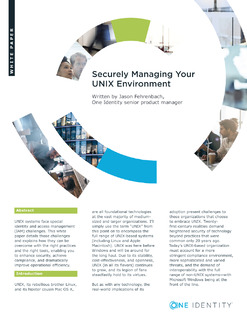UNIX systems face special identity and access management (IAM) challenges. This white paper details those challenges and explains how they can be overcome with the right practices and the right tools, enabling you to enhance security, achieve compliance, and dramatically improve operational efficiency.
UNIX, its rebellious brother Linux, and its hipster cousin Mac OS X, are all foundational technologies at the vast majority of medium-sized and larger organizations. I’ll simply use the term “UNIX” from this point on to encompass the full range of UNIX-based systems (including Linux and Apple Macintosh). UNIX was here before Windows and will be around for the long haul. Due to its stability, cost-effectiveness, and openness, UNIX (in all its flavors) continues to grow, and its legion of fans steadfastly hold to its virtues.
But as with any technology, the real-world implications of its adoption present challenges to those organizations that choose to embrace UNIX. Twenty-first-century realities demand heightened security of technology beyond practices that were common only 20 years ago. Today’s UNIX-based organization must account for a more stringent compliance environment, more sophisticated and varied threats, and the demand of interoperability with the full range of non-UNIX systems—with Microsoft Windows being at the front of the line.

